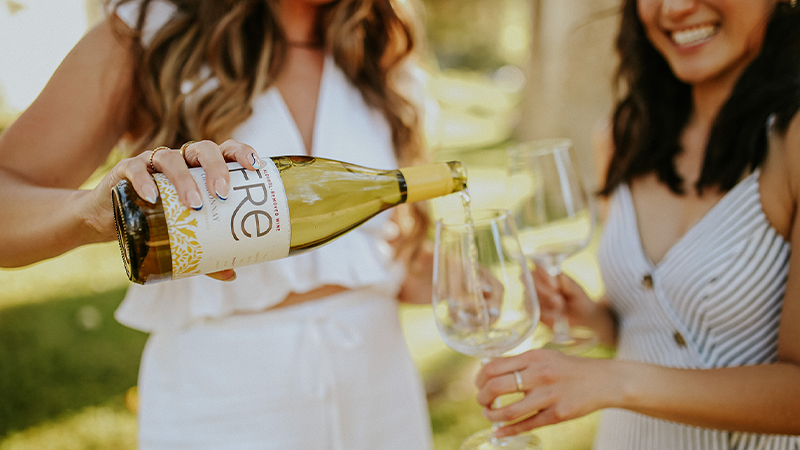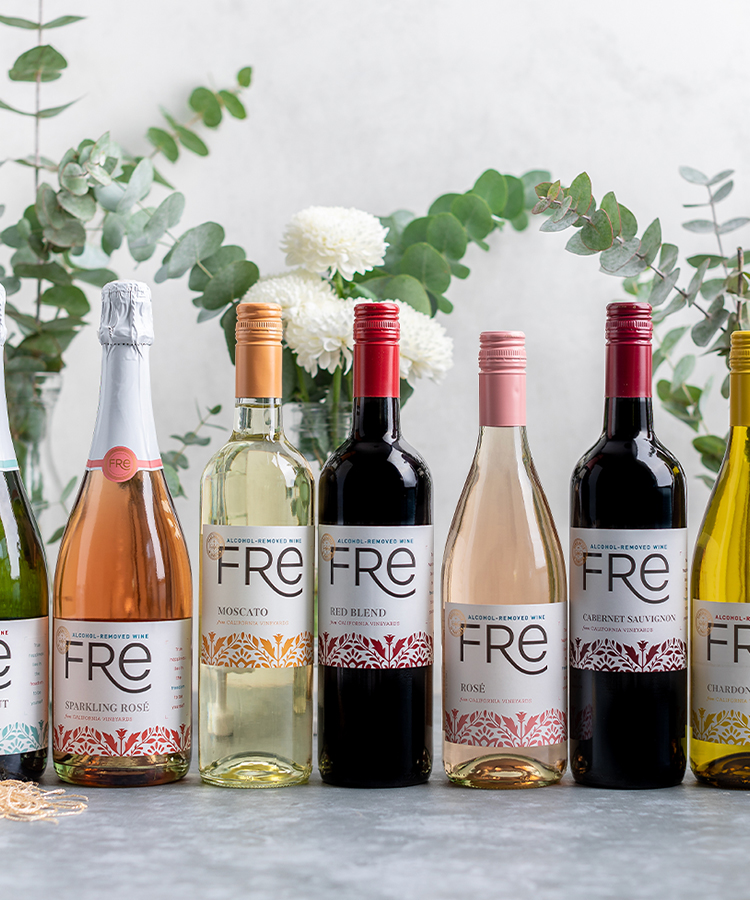
This article is sponsored by FRE wines.
January is here, and just like that we’re in a new year. For many, the beginning of a new year is seen as a time to let go of bad habits after the overindulgences of the holiday season. Cue the term Dry January, which was coined specifically to describe those who abstain from alcohol during January as a mini New Year’s resolution.
The trend in abstaining from alcohol, however, is becoming more of a lifestyle choice and less of a short-term goal. As Americans increasingly prioritize eating better, non-alcoholic beverages are replacing that typical bottle of beer or glass of wine. In fact, more than half of consumers took a break from alcohol in 2019, and one in five drinkers have reduced their consumption in the past year. While sparkling water cannot replace the way crisp sparkling wine bubbles dance over taste buds or the way a tannic red wine coats the tongue, preparing it for a bite of juicy steak, wine lovers can rejoice with alcohol-removed wine
Yes, you lucky duck, there really are wines out there you can swirl, sniff, and sip without worrying if it will lead to texting your ex at 2 a.m. Apparently sometimes you can have your cake and eat it, too.
Alcohol-removed wine is one of the fastest-growing segments of the beverage industry today. The Trinchero Family Estates is at the head of the pack with its portfolio of FRE alcohol-removed wine. The California-based winery joined the alcohol-removed wine market way back in 1992. Since then it has revolutionized a new way of wine drinking that keeps growing stronger every year.
“Last year spurred unprecedented growth for the brand,” said Glenn Andrade, Trinchero Family Estates Senior Vice President, Winemaking. With Americans increasingly prioritizing lifestyle, balance, and serenity, Andrade expects this growth trend will stick around for a while.
What Exactly Is Alcohol-Free Wine?
Is it sparkling grape juice? No. Is it just grape juice? Definitely not. True non-alcoholic wine is made with grapes that are fermented, vinified, and created into a fully alcoholic product before the alcohol is removed.
Wine is made from fermented grapes. During the fermentation process sugar is converted into alcohol. While grape juice alone is nothing more than the unfermented juice of grapes, it is much sweeter than wine because it does not undergo the fermentation process.
Creating FRE’s alcohol-removed wine is not much different from traditional winemaking — at least initially. The process begins with harvesting grapes. The Trinchero Family Estate owns close to 10,000 acres across California. With such a wide variety of vineyards, winemakers harvest grapes in premier vineyards known to cultivate grapes that beautifully express the characteristics of each varietal. FRE wines source grapes from Lodi, Clarksburg, and coastal California. After 30 years of experience, the FRE winemakers are experts at knowing which grapes will maintain the traditional structure, mouthfeel, and taste consumers expect even after the wine’s alcohol is removed.
FRE wines go through the same fermentation and aging process as traditional wine. “Following harvest, we craft each wine using traditional methods, achieving rich flavor, alluring texture, and excellent balance,” Andrade said. FRE is one of the only alcohol-free wine brands made from real California wine.
Once the wine is ready, winemakers use a revolutionary spinning cone column to delicately execute the de-alcoholization process while preserving the characteristics of the wine’s original flavors and aromas. The result is an alcohol-removed wine with less than one-half of 1 percent of alcohol. That is the same amount of alcohol as a kombucha or roughly equivalent to the alcohol content of orange juice left unrefrigerated overnight.
A Better Choice
In addition to being alcohol-free, FRE’s wines contain half the caloric content of traditional wine or soda. Each 8-ounce glass contains an average of 70 calories, making it a great alternative to juice or soda. Each glass is also vegan and gluten-free, so it checks all those beginning-of-the-year boxes.
But What Does It Taste Like?
Because FRE’s wine undergoes the entire vinification process, it tastes very similar to its traditional wine counterparts. FRE’s wine collection spans the gamut of great wines from California. Its nine varietals include Chardonnay, Cabernet Sauvignon, Merlot, Moscato, and White Zinfandel. In early 2020, the company released single-serve Sparkling Rosé and Sparkling Brut cans to provide festive options for those opting out of alcohol.
But those wanting the pop of a bottle should try the Sparkling Brut. Winemakers source the grapes for this wine from California’s cool, foggy marine-influenced vineyards where grapes ripen slowly, leading to bright acidity and crisp flavor. This dry sparkler with a crisp palate of apple and strawberry pairs nicely with creamy seafood pasta, nutty cheeses, or simply potato chips.
For an aromatic white, try FRE Chardonnay. Crafted from grapes grown in California’s warm, sun-soaked inland valley, this dealcoholized wine produces lively tropical fruit aromas. The palate is rich and creamy, leading to a lingering finish of crisp citrus and apple that pairs nicely with mild cheeses and creamy seafood and pasta dishes.
What goes better with a juicy blue-cheese-topped steak than a glass of full-bodied spicy Cabernet? Possibly nothing. FRE’s Cabernet Sauvignon is a deep red wine with dark cherry aromas and a bold palate of berries and spice. With less than 0.5 percent ABV, you can drink as much wine without worrying about making it through the dessert.
Now that we have wine sans alcohol covered, someone needs to work on chocolate cake sans calories.
This article is sponsored by FRE wines.
